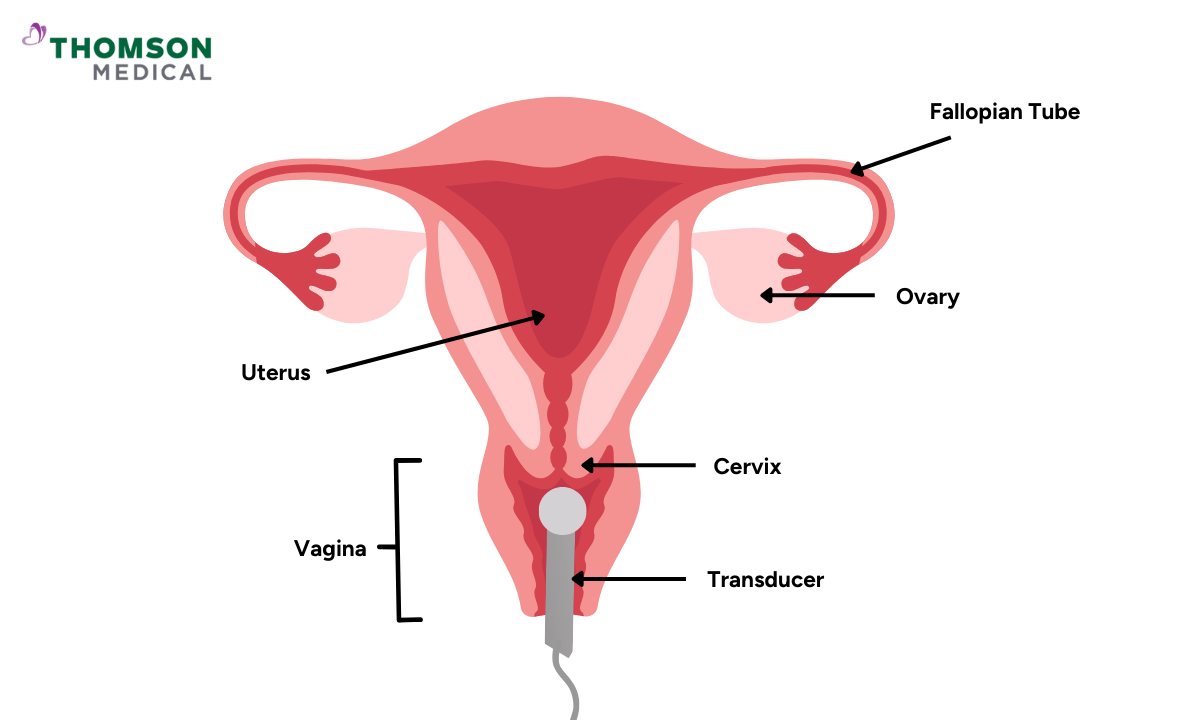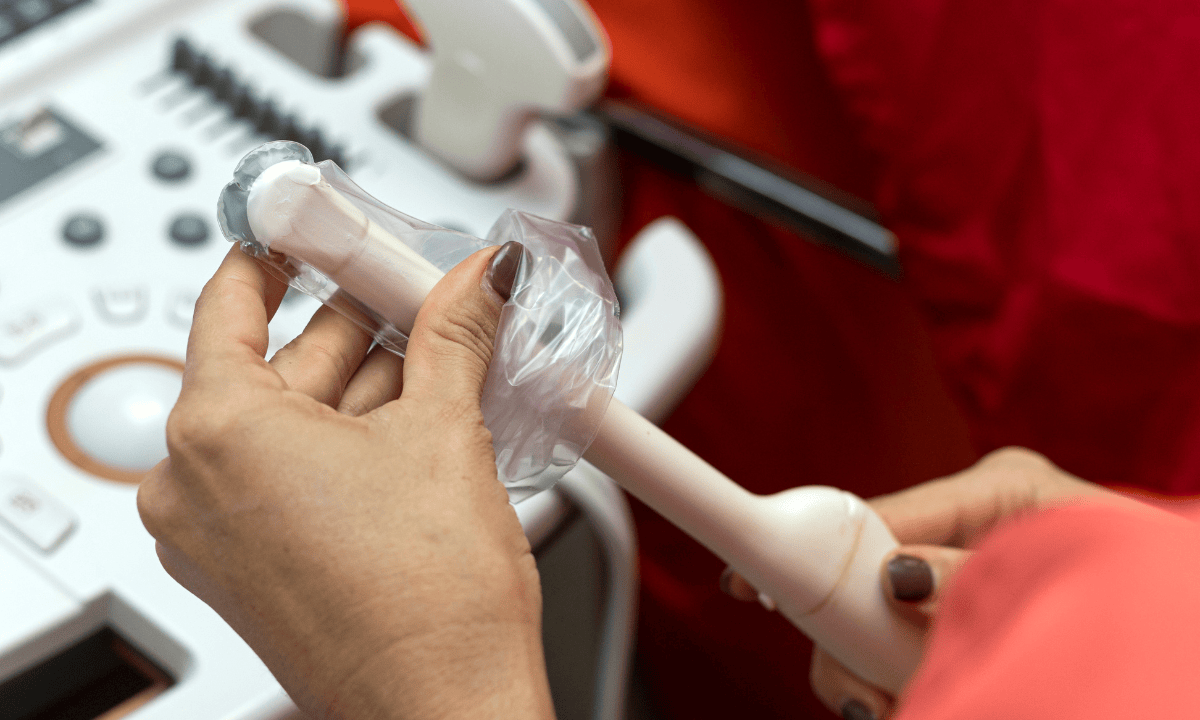What is a transvaginal ultrasound?
A transvaginal ultrasound is an imaging procedure that allows healthcare providers to assess the reproductive organs inside the pelvic cavity. This type of pelvic ultrasound produces more detailed, high-resolution images of the pelvic organs as compared to other pelvic ultrasounds, such as transabdominal ultrasound.
In Singapore, transvaginal ultrasound is widely available and can be performed at private clinics, polyclinics, or hospitals. It can be done as part of a general health check-up, as a stand-alone test to check for reproductive issues or to monitor pregnancy.
Find out more about our health screening services and how they can benefit you here.
How does a transvaginal ultrasound scan work?
Like other ultrasound scans, this test uses high-frequency sound waves to create a real-time image of the pelvic organs. A tube-shaped probe (transducer) is inserted into the vagina by an ultrasound technician known as a sonographer during the procedure.
Inside the vagina, this transducer then emits a sound wave that bounces off different pelvic organs, such as the uterus, ovaries, fallopian tubes, and cervix, as echoes.
These echoes return to the transducer at different speeds depending on the tissue they bounce off, helping the ultrasound machine distinguish between different types of tissue. A computer then processes this information to produce a real-time image, called a sonogram, which can be viewed on a screen.

Difference with an abdominal ultrasound
An abdominal ultrasound works slightly differently from the transvaginal ultrasound. In this test, the transducer isn't inserted into the vagina but instead pressed firmly against your pelvic skin, which results in less detailed imaging than a transvaginal scan.
However, abdominal ultrasounds are useful for guiding medical procedures, such as biopsies or egg retrieval for in-vitro fertilisation (IVF), as they can help pinpoint the needle's location. An abdominal ultrasound is also commonly used to monitor foetal development during pregnancy, often referred to as prenatal ultrasounds.
When do I need a transvaginal ultrasound?
A transvaginal ultrasound is a diagnostic tool used by healthcare providers to evaluate various reproductive health concerns, confirm early pregnancy, and identify other medical conditions. This imaging procedure can also provide further insights into any abnormalities found during a pelvic examination, aiding in accurate diagnosis.
Common reasons for a transvaginal ultrasound include:
1) Gynaecological conditions
Detecting abnormalities such as ovarian cysts, uterine fibroids, or polyps.
Diagnosing endometriosis or pelvic inflammatory disease (PID).
Identifying potential cancerous tumours in reproductive organs.
Evaluating the position and condition of an intrauterine device (IUD).
Assessing fallopian tube blockages that may affect fertility.
2) Symptoms assessment
Unexplained pelvic pain or discomfort.
Abnormal vaginal bleeding, including postmenopausal bleeding.
Irregular menstrual cycles or other menstrual problems.
Pain during intercourse.
3) Fertility and pregnancy assessment
Monitoring fertility treatments and ovulation.
Confirming early pregnancy, especially within the first 12 weeks.
Determining gestational age and monitoring foetal heartbeat.
Identifying a potential ectopic pregnancy (pregnancy occurring outside the uterus) or signs of miscarriage.
Examining the endometrial lining for implantation readiness.
Checking the cervix for changes that could lead to complications.
Evaluating placental position.
Your healthcare provider will explain why this procedure is recommended for your specific situation and what to expect during the examination. Although slightly more invasive than a transabdominal ultrasound, this procedure provides valuable diagnostic information that helps guide appropriate treatment and care.
If you are concerned about your pregnancy condition or other gynaecological issues, request an appointment with Thomson Medical. Our specialists can help with further diagnosis, including performance of a transvaginal ultrasound scan to determine the underlying causes of your symptoms.

What to expect during a transvaginal ultrasound
A transvaginal scan is a straightforward procedure that only requires minimal preparation prior to the scan, such as:
Using the restroom to relieve yourself, because this scan is usually done with an empty bladder.
Wear clothes that are comfortable and simple to remove, such as loose skirts or trousers, since you'll have to undress from the waist down and put on a gown.
If you’re on your menstrual cycle during the time of the scan, remember to remove any tampons beforehand.
Additionally, remove any jewellery or items that might interfere with the scan.
Your healthcare provider may also give specific instructions based on the test's purpose, so make sure to follow their guidance for the best results and reach out to them if you have any questions or concerns.
During the procedure
Once you’ve completed the preparation steps, the procedure will begin. Here’s what you can expect during the transvaginal ultrasound scan:
During the procedure, you will lie down on an exam table, with your feet and legs spread out.
A tube-shaped transvaginal transducer will be covered with a lubricated plastic or latex sheath. The transducer will then be gently inserted into your vagina, which may make you feel slightly uncomfortable.
The transducer will be gently turned and angled to bring the area of interest into focus. You may feel mild pressure as the probe is moved.
It will then transmit detailed images of the internal pelvic organs in real-time, including the uterus, ovaries, cervix, and fallopian tubes. This enables both you and your healthcare provider to observe them on a screen throughout the scan.
Once the procedure has been completed, the transducer will be removed.
After the scan is finished, the sonographer will send the results to a radiologist, a specialist in medical imaging, for analysis. Once the radiologist has reviewed the images, they will share their findings with your healthcare provider.
Your provider will then contact you to discuss any important findings, possible abnormalities, and suggested next steps based on the evaluation. This procedure is quick and painless, typically lasting between 15 and 30 minutes, allowing you to return to your regular activities right after the scan.
Always follow preparation guidelines and discuss any concerns with your doctor to ensure the most accurate results. Request an appointment with us to find out if a transvaginal ultrasound is the right imaging test for you.
Transvaginal ultrasound costs in Singapore
A transvaginal ultrasound in Singapore can be performed at a hospital, clinic, or diagnostic centre, either as an outpatient procedure or as part of your hospital stay. This scan can cost from SGD 130 to 200 as a standalone test, depending on which medical facility you choose.
However, if the ultrasound pelvis scan is part of a health screening package, prices can vary significantly, starting from around SGD 400 for a basic package and going up to SGD 3,200 for more comprehensive screenings.
To help cover the cost, you can use up to SGD 300 annually from your MediSave account at select clinics. If you have private insurance, you may need to check with your individual provider to see if a transvaginal ultrasound is covered by your policy.
The cost information provided above is intended for general reference only, as of 2025. For detailed fee information and payment options, please consult your healthcare provider directly. Request an appointment with our specialists at Thomson Medical today for a detailed price breakdown and a personalised care plan.

Risks
Transvaginal ultrasounds are safe, non-invasive imaging tests with no known risks because they don't use ionising radiation, unlike X-rays and CT scans. However, you might experience some mild discomfort during the test, such as:
Slight discomfort due to the insertion of the ultrasound probe into the vagina and its movement.
Since the transducer is covered with a plastic or latex sheath, patients with a latex sensitivity may experience an allergic reaction. Do let your healthcare provider know of such allergies before the test.
Although it is rare, there is a minimal risk of bacterial infection if the transducer isn't properly sterilised. However, there are strict hygiene measures that are in place to prevent this.
There might be a slight vaginal discharge from the lubricating gel used during the procedure, which usually disappears after 24 hours.
FAQ
Do I need to shave for a transvaginal ultrasound?
No, shaving or trimming is not necessary for a transvaginal ultrasound scan. This is because the test aims to examine the reproductive organs inside the pelvis using a tube-shaped transducer that's inserted into the vagina, which means that pubic hair does not interfere with this process.
How long does a transvaginal ultrasound take?
A transvaginal ultrasound is a relatively quick procedure that lasts between 15 and 30 minutes. During this time, the sonographer will carefully position and move the transducer to capture detailed images of your pelvic organs, including the uterus, ovaries, cervix, and fallopian tubes.
Is a transvaginal ultrasound painful?
A transvaginal ultrasound is usually not painful, but you may feel some mild discomfort during the process. You might feel some pressure when the lubricated transducer is inserted into your vagina and as it's gently moved to capture images of your pelvic organs.
Do you need a full bladder for a transvaginal ultrasound?
No, you do not need a full bladder to perform a transvaginal ultrasound, unlike a transabdominal ultrasound. This is because the transvaginal scan allows for direct ultrasound imaging of the pelvic organs without needing the acoustic window that a full bladder provides in transabdominal imaging tests.
Is transvaginal ultrasound okay for virgins?
Yes, a transvaginal ultrasound is safe for virgins. While it may feel a little more invasive, the procedure is designed to be gentle, and the healthcare provider will ensure that you are as comfortable as possible.
If you have concerns, you can discuss them with your provider beforehand to make sure you feel at ease. They can explain the procedure in detail and discuss any potential implications.
The information provided is intended for general guidance only and should not be considered medical advice. For personalised recommendations based on your medical conditions, request an appointment with Thomson Medical.
For more information, contact us:
Thomson Specialists Paragon (Health Screening)
- Mon - Fri: 8.30am - 5.30pm
- Sat: 8.30am - 12.30pm
Call: 6735 0300
Request a Health Screening